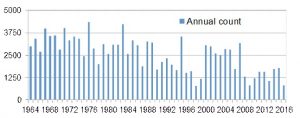Systematic Government failure to heed warnings regarding the consequences of intensive salmon farming
– Salmon & Trout Conservation Scotland Press Release –
– 8th August 2017 –
This year’s run of salmon in the most closely monitored river in Argyll is on course to be the lowest on record. The salmon count on the River Awe has hit an all-time low after 30 weeks of the season.
Last year’s total of 807 fish was only slightly above the all-time lowest count. This year it is running at only one third of the 2016 count. If this continues the final total will struggle to reach 400. This would be by far the lowest count of returning salmon to the biggest river in the South-West Highlands since records began in 1965.

River Awe Salmon Count
The Awe is a short river, draining Scotland’s longest loch (Loch Awe), with a hydro-electric dam at its head. There is a fish lift and a counter in the dam. The flow regime is such that fish can run the river any day of the year; almost all the fish are destined for the headwaters and thus there is a full river count which is almost unaffected by the weather.
Roger Brook, Chairman of the Argyll District Salmon Fishery Board, said:
“The Scottish Government has promoted the continued expansion of the salmon aquaculture industry whilst refusing to implement adequate control on the siting of farms and the levels of sea lice on the farms. We call upon Scottish Government to insist that future farms are sited away from the probable migration routes. The worst existing farms, both in terms of location and lice control, should now be closed.”
Mr Brook continued:
“Rivers such as the Awe are facing an uneconomic future but the government appears to care nothing about our iconic west Highland salmon and the important west coast tourist industry associated with recreational fishing. We are facing a very precarious future.”
Andrew Graham-Stewart, Director of Salmon and Trout Conservation Scotland (S&TC Scotland), said:
“Since the arrival of intensive salmon farming, numbers of mature west Highland sea trout have crashed. The decline in wild salmon numbers has not thus far been as extreme but it now appears that in the southern section of the west Highlands the decline is accelerating into a free fall.”
Mr Graham-Stewart added:
“Despite all the warnings regarding the consequences of pursuing the unfettered growth of salmon farming without any meaningful controls to protect wild fish, successive Scottish Governments have blundered on with this policy.”
In an attempt to quantify the effect of salmon aquaculture, a comparison can be made between salmon catches on the East coast of Scotland and the west coast between the Mull of Kintyre and Ardnamurchan Point (South-West Highlands). Between 1970 and 2014 rod catches of salmon on the East coast increased by almost 40%. Over the same time period rod catches in the South-West Highlands declined by 50%. See http://www.salmon-trout.org/pdf/South-WestHighlandsSalmonFishery1.pdf
Juvenile salmon migrating from rivers in the South-West Highlands must run the gauntlet close to lice-producing salmon farms not only in the immediate area but also the whole way up the west coast before they reach open ocean, free of aquaculture. Throughout this coastal migration they are vulnerable to infestation by deadly sea lice. It stands to reason that, the more salmon farms that outgoing juvenile salmon have to negotiate past on their migration to the North Atlantic feeding grounds, the less likely they are to survive.
The other major river in the South-West Highlands is the Lochy, which enters the sea by Fort William. The published rod catch of salmon to the end of July was 33, summed up by the river’s management as “the worst start in recent times.” The catch to the end of July was just 27% of the five year average for the same period. See http://www.fishpal.com/Scotland/Lochaber/lochy/?dom=Pal
In June, the Scottish Parliament’s Rural Economy and Connectivity Committee, in response to a formal Petition lodged in the Scottish Parliament in February 2016 by S&TC Scotland seeking protection for wild salmonids from sea lice from Scottish salmon farms, agreed to launch an Inquiry (scheduled for early 2018) into salmon farming in Scotland and the issues raised by S&TC Scotland.
S&TC Scotland believes that a future is possible where Scottish salmon farming and wild fish can both thrive but in the medium term this can only be achieved by moving farming into closed containment tank systems, thus preventing the spread of disease and parasites from the farms to wild salmon and sea trout. In the meantime effective regulation of farms to protect wild fish is long overdue.
ENDS
Issued by Andrew Graham-Stewart (telephone 01863 766767 or 07812 981531) on behalf of Salmon and Trout Conservation Scotland.